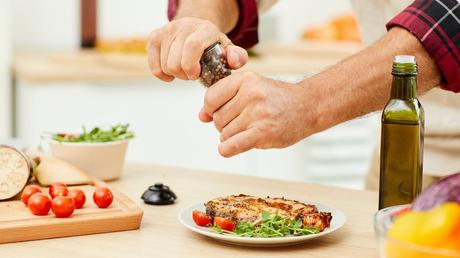Have you ever wondered what the difference is between total carbs and net carbs? Do you know which one is better to track if you're eating a low-carb diet - or if it matters at all?
This guide will explore these questions to help you understand which approach is right for you.
When you calculate net carbs for whole natural foods, net carbs are the total carbs in a particular food minus the fiber.
For processed foods, you may need to subtract sugar alcohols as well (more on this in the section on sugar alcohols)
Given the calculations, total carbs are almost always higher than net carbs. At Diet Doctor, we define the different levels of carbohydrate reduction according to net carbs. Below are our three levels, startified by net carbs and including estimates for total carbs:
- Strict low carb - less than 20 grams of net carbs (30 grams of total carbs)
- Moderate low carb - 20 to 50 grams of net carbs (30 to 70 grams of total carbs)
- Liberal low carb - 50 to 100 grams of net carbs (70 to 130 grams of total carbs)
Our advice
- Focus on net carbs when eating whole, natural foods such as vegetables, fruit, beans, and legumes.
- Focus on total carbs when eating processed food products with added fiber, such as bars and baked goods.
Get your personalized meal plan with a FREE 30-day trial!
Why measure net instead of total carbs?

The main reason to track net carbs is that dietary fiber doesn't provide calories or affect glucose and insulin the same way as non-fibrous carbs.
If you have diabetes, pre-diabetes, metabolic syndrome, or obesity, scientific evidence demonstrates significant benefit from limiting your carbs. But research also shows potential benefits from eating fiber. Therefore, one helpful approach could be to eat high-fiber foods that are low in net carbs, such as low-carb vegetables like leafy greens, broccoli, and zucchini.
Here are some examples:- Half of an avocado has 9 grams of total carbs, but only 2 of those grams are net carbs because 7 grams are fiber carbs.
- One cup of broccoli has 11 grams of total carbs, 6 grams of net carbs plus 5 grams of fiber carbs.
- Two-thirds of a cup of raspberries has 11.5 grams of total carbs, made up of 5 grams of net carbs and 6.5 grams of fiber carbs.
If you enjoy a lunch made with chicken thigh, avocado, broccoli, and raspberries, you would eat 31.5 grams of total carbs, of which 13 grams are net carbs and 18.5 grams are fiber. That means you would - with just this meal - reach your daily carb limit if you follow a diet aiming for 30 grams of total carbs.
But if you follow a diet aiming for 20 grams of net carbs, you have some room to add high-fiber carbs at dinner and potentially benefit from the extra fiber intake.
That's why our recommendation is to track net carbs when eating whole, unprocessed foods. Fiber isn't just "free" from a calorie and blood sugar perspective; it's potentially beneficial for weight loss, blood sugar control, and short-term satiety. And tracking net carbs lets you eat more fiber!
See if some of your favorites are on our list of the top 15 high-fiber, low-carb foods.
Why measure total carbs?
It's easier to measure total carbs - no subtraction necessary!
The benefit of measuring total carbs is most evident when it comes to manufactured or packaged products.
The effect of the natural insoluble fiber found in fruit and veggies is well known and has been well-studied. It's called insoluble fiber because your body doesn't absorb it at all.
Naturally-occurring soluble fiber is a little different. Soluble fiber forms a gel and increases the viscosity of the digested food. While some soluble fiber may get absorbed, it is more likely that it gets fermented by gut bacteria. Therefore, soluble fiber can contribute a small number of calories, but it doesn't usually impact blood sugar and insulin significantly.
However, the fiber added to packaged food products is often the kind of soluble fiber that can contribute to increases in blood sugar and insulin.
For instance, isomaltooligosaccharide (IMO) significantly raises blood sugar and insulin levels. Food manufacturers often count IMO as fiber and subtract it from total carbs to market a low-net-carb product. Unfortunately, your body will not agree.
Other examples of added fibers are inulin, xanthan gum, tapioca fiber, and chicory root. While none of these will likely cause the same adverse reaction as IMO, we still recommend caution as many of these added fibers have not been extensively studied.
Because of the unwanted potential effects of these ingredients, we recommend counting net carbs for whole natural foods and total carbs for processed food products.
Pro tip
Outside the US, most nutrition labels remove fiber from the total carb count, automatically reporting net carbs. So make sure you read the label carefully. If it has IMO in the ingredients, the label may not reflect carb content accurately.
Sugar alcohols
Sugar alcohols don't occur in significant quantities in natural foods. However, they're common in processed food products and baked goods.
Some, like erythritol, do not meaningfully contribute any calories or affect blood sugar. However, xylitol and mannitol can make a small contribution, while maltitol, sorbitol, isomalt, and glycerin make a more significant contribution.
Conclusion
When it comes to net versus total carbs, our advice is simple:
- Count net carbs for whole foods. Just subtract the naturally-occurring fiber from the total carbs.
- Count total carbs for packaged or processed foods, and try to stay away from products that have IMO or maltitol.
What if you eat a mix of whole foods and processed foods? You can target a middle point between your net carb and total carb goals. It may not be an exact science but should get you close.

